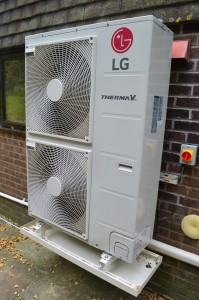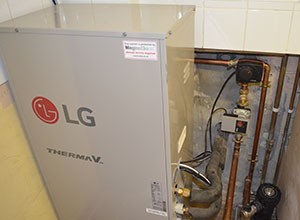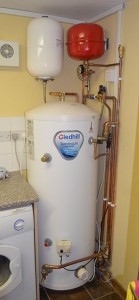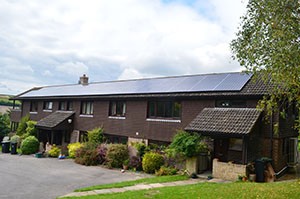explore the BusinessNet
THERE’S ‘RENEWABLE’ GOLD, IN THEM THAR HILLS!!
Story
 When Paul and CatheHazlewood decided to leave the agreeable urban living environment they had enjoyed for years in the centre of Oxford, looking for a new life in the country, they and Cathe’sbrother and sister-in-law decided to head for deepest Dorset.
When Paul and CatheHazlewood decided to leave the agreeable urban living environment they had enjoyed for years in the centre of Oxford, looking for a new life in the country, they and Cathe’sbrother and sister-in-law decided to head for deepest Dorset.
The sale of their properties allowed them to shop around for an idyllic setting that they could remodel to suit the lifestyle choices they wanted to make with energy efficiency, ‘green’ living and utilising modern renewable technologies an important factor in their decision-making.
What they found exceeded their wildest dreams and allowed them to reshape their futures in a way that whilst they had hoped might be possible, they needed to see to believe. The property they purchased allowed them both to enjoy large adjoining semi-detached properties, on a plot that included a large building that had been built and envisaged as a ‘business centre’ although it had never quite managed to be that, extensive woods and views across the Dorset countryside to die for.
Paul and Cathe admit they were not renewable experts. Being intelligent people they had a grasp of what was available but knew only a little more than the average person when it came to what they could go with and how those options might fit together. They were convinced they would go with solar PV to generate their electricity – the properties they had chosen were blessed with south east and south west facing roofs – and were sizeable, allowing them to install a solar array that would more than meet their requirements. They thought they might possibly go for a biomass boiler option – they had the woods and a pretty much endless supply of fuel available so they wouldn’t necessarily be reliant on a supply of expensive wood pellets.
 They had an initial successful environmental ‘hit’. They inherited a home that was lit entirely by halogen lamps set into ceilings around the home. They quickly switched these all to LEDs and cut their lighting bill by 90%. This and the impending arrival of an 18kW solar PV system on the roof was beginning to shape the future for the couple. But the deeper they got into planning their future the more they began to realise they needed to talk to someone. Someone they could trust who really understood renewables and how they might work together to provide the best energy solutions for them. There is no ‘off the shelf solution’ – it needed someone who really understood the options to sit down with them, take them through the options and lead them gently towards the holy grail – an integrated heating, hot water and lighting system that met their very particular needs.
They had an initial successful environmental ‘hit’. They inherited a home that was lit entirely by halogen lamps set into ceilings around the home. They quickly switched these all to LEDs and cut their lighting bill by 90%. This and the impending arrival of an 18kW solar PV system on the roof was beginning to shape the future for the couple. But the deeper they got into planning their future the more they began to realise they needed to talk to someone. Someone they could trust who really understood renewables and how they might work together to provide the best energy solutions for them. There is no ‘off the shelf solution’ – it needed someone who really understood the options to sit down with them, take them through the options and lead them gently towards the holy grail – an integrated heating, hot water and lighting system that met their very particular needs.
Living in deepest Dorset, there might have been initial panic. Would they find such a person, or such people. They were recommended to talk to local experts Bublshop. Bublshop had been operating in the area under its name and a previous one – Dorset Energy Solutions – for several years and was driven by two knowledgeable guys – xxx xxx and Martin Perrin, both dedicated to working with renewable options, both well versed in the options available and with the experience to be able to advise pretty much anyone about what was best for them. Specifically. And that is exactly what they did for Paul and Cathe.
After a lengthy chat they decided to start with the solar PV system and then rather than going with biomass, to look at the latest high temperature air source heat pump from LG as the source of their heating and hot water. The homes they had bought were both fuelled by elderly and inefficient oil boilers and they quickly realised that that was not the way forward for them.
 The solar PV 18kW array would see them exporting around 50% of the electricity they generated. They were attracted by the idea of storing electricity if they could but decided to put of this extension of the system until the technology to do it was cheaper and more reliable. It’s on their agenda!
The solar PV 18kW array would see them exporting around 50% of the electricity they generated. They were attracted by the idea of storing electricity if they could but decided to put of this extension of the system until the technology to do it was cheaper and more reliable. It’s on their agenda!
The feed in tariff (FIT) and Renewable heat incentive (RHI) weren’t essential decision makers for the solar PV or the heat pump although it was a significant help especially for the heat pump: “It is a nice bonus,” says Paul, “but it wasn’t a dealmaker or breaker. Because of the sale of our home in Oxford, we could pay for these up front, but the heat pump decision might have been a bit more difficult if we hadn’t had the RHI payments to look forward to over the next seven years.”
The LG Therma V high temperature air source heat pumps – one for each home – have been a huge eye opener to the couple. They had got used over twenty years to heat on demand using a traditional boiler. They had got used to the ease of having gas through the mains. There was concern initially about how responsive the air source heat pumps would be to deliver heat and hot water when it was needed. But with the latest ‘high temp’ system from LG they say they shouldn’t have worried: “It’s not a flippant remark,” says Paul, “but the heat pump is up and running and commissioned and the biggest compliment I can pay it is that we don’t actually notice the difference! It’s pretty rapid to respond – we’d heard stories about having to switch the thing on several hours before you needed hot water – but that’s just not the case. You quickly adjust to the new kit and it’s been excellent for us since we moved in and got it up and running.”
Bublshop’s Martin Perrin says this is the beauty of the new high temperature heat pumps from LG: “Low temperature air source heat pumps really need to be on 24 hours a day to bring the temperature of the home up to the required temperature and keep it there. They work well and for the right home, they do a great job. But if you need the security of almost instant response the high temperature ASHP is the one to choose. And they’re not hugely more expensive than the low temperature units. People who have them use them very much like boilers and they respond to that kind of use. The key to success is to get the heating system design right at the outset. Work through what you need, your lifestyle requirements and build those into a hardware design that delivers it. It sounds simple and is when you have considered all the complications. Once it’s sorted, it works a treat.”
We know its far more energy efficient and much more environmentally friendly to use renewables than fossil fuels. But what about costs?
 “It’s difficult to be exact because we don’t have historical oil usage figures for the properties here – so we can’t measure or compare the costs but in our experience the savings over oil are in excess of 50% per year – and that’s impressive,” says Martin. We will be monitoring the ‘real time’ costs of the air source heat pump and we’re confident it will be mightily impressive when compared with any other forms of heating and hot water comfort provision.”
“It’s difficult to be exact because we don’t have historical oil usage figures for the properties here – so we can’t measure or compare the costs but in our experience the savings over oil are in excess of 50% per year – and that’s impressive,” says Martin. We will be monitoring the ‘real time’ costs of the air source heat pump and we’re confident it will be mightily impressive when compared with any other forms of heating and hot water comfort provision.”
In modern homes, with several bathrooms – certainly a couple of en-suites and a family bathroom becoming commonplace – and the new standards of insulation and heating, it’s common to see heating demand halved and hot water demand tripled – so high temperature air source heat pumps are ideal for this scenario – perfect for refurbishment projects like this one – but spot on for new build properties.
“The way homes are built these days is very different and the issues we face have changed hugely,” says Martin. “We’re delighted to have access to the technology we have from LG through the distributorship we have in this area. It gives us huge competitive advantage and a range of new options that we know work, that are cost effective and energy efficient and that allows us to combine renewable technologies in a way that we haven’t been able to before.”
To find out more about LG high temperature air source heat pumps head to http://partner.lge.com/uk, or www.bublshop.co.uk or you can email LG at HVAC.marketing@lge.com.
